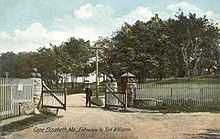Fort Williams (Maine)
Fort Williams is a former United States Army fort in Cape Elizabeth, Maine which operated from 1872 to 1964. After its closure, it was redeveloped into Fort Williams Park.
History

A 14-acre purchase in 1872 served to establish a sub-post to Fort Preble located at Spring Point. This fortification became known as Fort Williams on April 13, 1899, by order of Army Headquarters (General Order No. 17, Headquarters of the Army, Adjutant General's Office, Washington, D.C.). It was named for Brevet Major General Seth Williams.
The Board of Fortifications, often called the Endicott Board, recommended a comprehensive program of new fortifications in 1885. Fort Williams was one of the results. It first test-fired its guns in 1898, shortly before the outbreak of the Spanish-American War, and was complete by 1906.
As built, the fort contained three batteries: Battery Sullivan (two 10-inch guns on disappearing carriages, Battery DeHart (three 10-inch disappearing guns) and Battery Hobart (one 6-inch Armstrong gun), all built between 1896 and 1898. Three other 2-gun batteries were added later: Battery Blair, 2 12-inch disappearing guns (1903); Battery Garesché, 2 6-inch disappearing guns (1906); and Battery Keyes, 2 3-inch rapid-firing guns (1906), the latter to guard a minefield. The remains of a wharf for loading mine planters can be seen near Battery Keyes. Searchlights were also mounted at various batteries.[1]
Between 1900 and 1911, most of Fort Williams' support buildings were constructed, including enlisted barracks, non-commissioned officers' quarters, commissioned officers' quarters (Officers' Row), hospital, gymnasium, post exchange, bakery, abattoir, commissary, laundry, chapel, fire station, Fort headquarters, and other buildings including garages and storage sheds. Infrastructure included an electrical substation, a bunkered telephone switchboard, and pumps and underground storage tanks for gasoline and fuel oil. Recreational facilities included a baseball diamond with concrete bleachers, and clubs (the officers' club utilized the already existing Goddard mansion, purchased by the government and added to the property).
During World War I, the fort was fully manned by artillery companies and National Guard troops. Anti-aircraft guns were added to the defenses during this time. Fort Williams served as the headquarters of the Harbor Defenses of Portland throughout World War II, during which time the last of the coastal artillery pieces were removed due to age and obsolescence.[2] The fort was replaced by the 16-inch Battery Steele on Peaks Island and a few other more recent batteries. In January 1950, Fort Williams' mission was officially changed from a harbor defense post to a logistical and administrative support installation for all military units and personnel in the State of Maine.
On Saturday, June 30, 1962, Fort Williams officially closed and was turned over to the General Services Administration to be sold. The property was sold to the Town of Cape Elizabeth on December 1, 1964. Many of the fort's buildings were gradually torn down, though several structures remain, either intact or as preserved ruins. Most of the concrete bunkers and gun emplacements were backfilled, although Batteries Keyes and Garesche survive relatively intact, and the outlines of all the other emplacements were preserved on the surface. One of the two emplacements of Battery Blair was recently unearthed again, with its surfaces cleaned and painted and interpretive signage added; plans are being made to restore Blair's second emplacement in like manner.[3]
Present
After proposals ranging from a Coastal Science Park to low-income housing, the Cape Elizabeth Town Council designated Fort Williams on July 23, 1979, as Fort Williams Park. The park has been maintained for residents and non-residents for no fee. Recreational facilities include two tennis courts, a basketball court, baseball diamond, a course for physical fitness, picnic tables and cookout facilities, a picnic shelter, and recreational opportunities for walking, running, and dogwalking. All visitors to Portland Head Light pass through the park, adding to its visibility. The Beach to Beacon 10K is one of the park's largest events of the year.
See also
- Cape Elizabeth, Maine
- Casco Bay
- Port of Portland (Maine)
- Seacoast defense in the United States
- United States Army Coast Artillery Corps
References
- ↑ Fort Williams article at FortWiki.com
- ↑ "U.S.Navy Activities World War II by State". U.S. Naval Historical Center. Retrieved 2012-03-07.
- ↑ Murphy, Edward D. (December 2, 2011). "History buried at Fort Williams Park". Portland Press-Herald. Retrieved 1 September 2012.
- Berhow, Mark A., Ed. (2004). American Seacoast Defenses, A Reference Guide, Second Edition. CDSG Press. ISBN 0-9748167-0-1.
- Lewis, Emanuel Raymond (1979). Seacoast Fortifications of the United States. Annapolis: Leeward Publications. ISBN 978-0-929521-11-4.
External links
Official websites
- "Fort Williams Park". Town of Cape Elizabeth - Fort Williams Park.
- "Portland Head Light". Portland Head Light.
- "Fort Williams Park Foundation". Fort Williams Park Foundation.
- List of all US coastal forts and batteries at the Coastal Defense Study Group, Inc. website
- FortWiki, lists all CONUS and Canadian forts
- Gun types at FortWiki
| ||||||
Coordinates: 43°37′24″N 070°12′40″W / 43.62333°N 70.21111°W